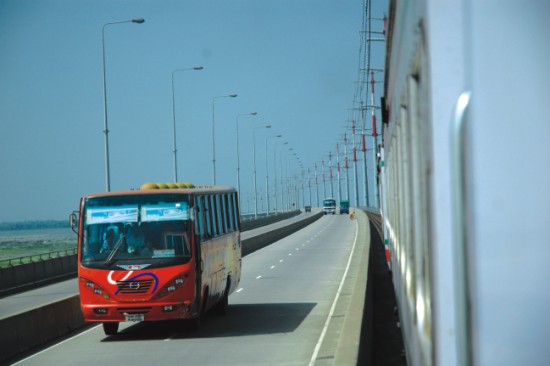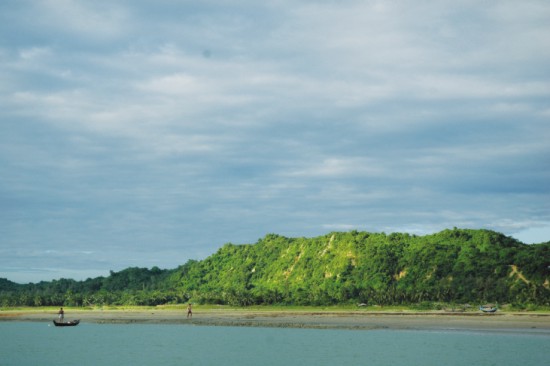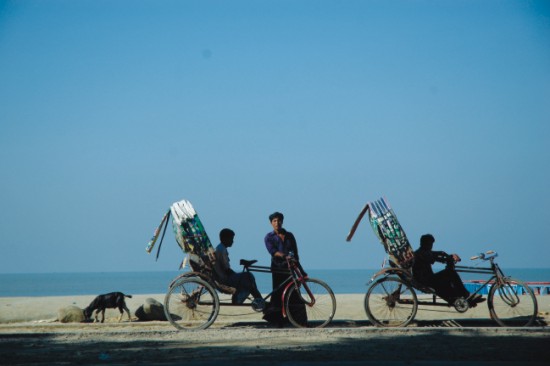
Inside
|
Dream or Reality? Abul Hashem runs a critical eye over the Asian Highway The Asian Highway's (AH) 141,000 km route charted out by Escap is a long way indeed. One will also have to go a long way to see it materialise. Many of us who dream of seeing loaded containers from Shanghai or Singapore, or from Dhaka for that matter, rolling down this route to Istanbul and beyond may not live to see it fulfilled.
Fifty years have gone by since the AH was conceived. Some progress has been achieved in recent years in defining the road links on the basis of an agreement among some of the countries. Much more remains to be done. It is not certain how long it will take to make traffic movement possible along this dream route across the Asian continent. It is possible, however, that neighbouring countries through which the route passes can use it to cross into each others' territories provided they can complete their road infrastructure -- following specified standards -- and agree to open their border points for movements across the borders. Against this backdrop, I would like to see the prospects and possibilities of the proposed Asian Highway from a Bangladeshi perspective. I take the cue and clues from an interview by Dr. Rahmatullah, ex-director of the transport and communication division of Escap, published in The Daily Star on June 19. He has been a vocal advocate of the AH because he handled the project since 1978 until his retirement in 2000, first as the substantive officer in the roads and highways section and later as director of the division. He has, thus, been instrumental in defining the road alignments and border crossing points on the basis of consultations with and submissions of individual countries regarding their road stretches to be designated as part of the AH. At the very outset, I have to express scepticism regarding the enormous economic benefits seen for Bangladesh from joining the network, enabling it to move by land across the continent(s). The long haul traffic movement may remain a distant dream given the complexities that have to be sorted out before traffic can move on. Even if it becomes possible otherwise, Bangladesh's benefits from such long haul road traffic westward may remain limited at best. I shall explain later why that is so. The route as currently proposed will also make it useless for Bangladesh to move to the east and southeast. However, if Bangladesh signs and ratifies the network agreement, neighbours can press it to open its borders through the proposed links where advantages are seen in traffic movements within the neighbourhoods. Bangladesh, in fact, has now decided to sign the network agreement, accepting the three routes designated by Escap within its territory. The argument in favour of entering the agreement has been that Bangladesh will remain isolated from the world, especially from the Euro-Asian continent, if it fails to connect to the AH network. In that event, the AH will bypass Bangladesh, and we will be left it our own cocoon and lose out on the huge potential economic benefits to be reaped by joining. It is not clear, however, where the Asian Highway will go westward if Bangladesh refuses to sign the network agreement. Can it go through the Shiliguri corridor of India, the so-called "chicken neck"? It does not seem probable since India itself is quite unwilling to use that corridor for reasons of security, the long distances and high costs -- for which India has been asking for an easy passage through Bangladesh.
I am, however, not arguing against Bangladesh joining the AH network, only that it must serve the country's best interests, and the AH passing through Chittagong-Cox's Bazar-Myanmar and beyond is the way to ensure that. Since its inception in 1959, we had the impression that the AH would pass through Cox's Bazar-Myanmar (then Burma) and onward east and west. The AH was one of the two major regional projects initiated by then ECAFE -- the other was the Mekhong River project. The Trans-Asian Railway project was added to the list later. It may be mentioned here that the Asian Development Bank was also set up under the auspices of ECAFE, with the primary focus on providing the financial underpinning to the regional projects like these. The projects, however, remained stalled due the Indochina war and the path of isolation chosen by Burma's military government since 1960. Escap (ECAFE's new name since 1974) revived the projects in the 1980-1990s. The Mekhong River project has been successfully implemented to the satisfaction of the riparian countries, with financial assistance of bilateral and multi-lateral donors. By now, the AH has advanced a stage as indicated above. In this advance Bangladesh has, however, fallen on the wrong track. The two main arteries of the AH (AH1 and AH 2) enter Bangladesh from India in the west and converge on to Tamabil in Sylhet before crossing into the Indian state of Meghalaya on to Assam, Monipur and Nagaland. It can go further to Myanmar, south-east Asia and China, and can serve as a sub-regional network in that area, though its suitability as a continent-wide Asian Highway remains in doubt. Dr. Rahmatullah has made it abundantly clear that the route through Tamabil is unsuitable for the AH. In addition to the 1,200 km extra distance, he says: "The route passes through a mountainous region and four Indian states, through which vehicles can move only slowly as the gradients are steep. Trucks with heavy load will have difficulties in moving, fuel consumption will be huge, making travel costly. Tamabil is not suitable for India, Myanmar or Bangladesh, or for any country between south and south-east Asia." Now let us have a detailed look at the designated three routes through Bangladesh. AH 1 and AH 2 enter Bangladesh from India through Benapole in Jessore and Banglabandha in Dinajpur, respectively. Both converge on Dhaka and move on to Tamabil, Sylhet. Neither of them fulfill the requirement that the AH connects the ports, container depots and business centres of participating countries. The justification for a second entry into Bangladesh through Dinajpur has been to give access to Bhutan and Nepal to the AH. The third route through Bangladesh (AH 41) will originate at Mongla port and move on to Jessore to meet AH 1 just after the Benapole border crossing, and then move on to Hatikamrul in Kushia to meet AH 2. After merging with both AH 1 and AH 2, AH 41 travels to Dhaka and then separates and moves to Chittagong, Cox's Bazar, and Teknaf. There is no indication that this route will move into Myanmar and beyond. The route has been designated as a sub-regional route though it traverses Bangladesh territory only. India, Nepal, and Bhutan are potential users. No other country will use this route. It compensates for the main AH routes by-passing ports, container depots, business centres etc, and allows access to ports to India, and Nepal and Bhutan if they can transit through India. The Indian desire to use Bangladesh ports could be easily fulfilled, and it could perhaps be the second best choice. It is agreed by all that the route through Tamabil Meghalaya, Assam, Monipur, Nagaland to Myanmar is not viable economically (distance and costs), physically (hilly terrain) and security-wise (because of the insurgencies in the region) for Bangladesh or for other countries except India. It is also agreed that the Chittagong, Cox's Bazar, Teknaf, Myanmar route is the shortest, most economical and relatively safe, not only for Bangladesh, but for all countries in the east and west. Another alternative that has been talked about is a crossing from Austogram, Sylhet to Karimganj, Assam to Tamu on the Myanmar border, which would reduce the distance compared to the route through Tamabil. Bangladesh did not take this offer for reasons not quite known. The reasons why Escap could not consider the Chittagong-Cox's Bazar-Myanmar route as the Asian Highway were that more than a 100 km road link from Gundum in Myanmar to the Bangladesh border was totally missing, a 600 km Yangoon-Gundum road was too narrow and sub-standard, and, above all, Myanmar was not interested in developing this route because of the costs involved and also perhaps the political considerations as the road political considerations as the road will pass through the Rohinga country in the Arakan province. The minister for transport and communication in the BNP government of 1991-95 is said to have approved the route alignments through Bangladesh, which he denies. The truth in this regard can be easily established because the proof must be there in the government files and records as well as in the memories of permanent officials who were involved in the process. It is obvious, however, that someone at some time must have approved or endorsed these routes through Bangladesh. Escap could not have included them in the AH network without such approval. Whoever may have done it, has done a great disservice to Bangladesh's cause. It has become clear that the route through Tamabil will be of no use to Bangladesh for reasons of physical difficulties of passage through it, and the cost and security concerns. The controversy is about whether this route would serve merely as a transit corridor for India to carry its cargo of men and materials from one part to another through Bangladesh. I believe that the corridor concept is somewhat misplaced in this context. A corridor implies a narrow strip of sovereign territory of a country connecting one part of the country to another part through the territory of another country. Bangladesh also will not be required to cede its sovereignty on the Asian Highway roads, and the AH cannot, strictly speaking, be a corridor to any another country. It is more appropriate to say that the AH, as it is currently proposed and accepted, will be an Indian highway through Bangladesh, since few other countries, if any, will use it.
The present government of Bangladesh has already decided to sign the network agreement by accepting the proposed routes. It is said that, according to Escap-crafted laws, Bangladesh cannot even propose any amendment to the routes now without signing the agreement first. And not signing will mean that Bangladesh will be left out and the AH will by-pass Bangladesh, leaving it isolated and causing it to lose vast opportunities of trade, investment and service revenues. This assertion has been made despite the knowledge that the cost-benefit of the proposed routes does not favour Bangladesh at all. By-passing Bangladesh through the Indian "chicken neck" is also improbable, as stated before. Bangladesh has a bargaining chip here if the member countries of Escap are serious about running the AH from east and south-east Asia to the sub-continent and beyond. It is not clear whether the present government will seek to renegotiate the routes and how easy it would be if it does. It is pointed out that Escap had made an attempt in 1997-98 to alter the Tamabil-Meghalaya route to Ostgram-Karimganj-Tamu. The attempt failed. The reason for the failure is not stated, nor is it clear what role the then-government of Bangladesh had in that attempt at renegotiation. It may be suspected that the failure was due to Indian opposition. The initiative of the previous political government to establish an outlet through Cox's Bazar-Myanmar has apparently fallen through. It has been suggested that even if Bangladesh wants to negotiate the Cox's Bazar-Mynmar route it must have the agreement of Myanmar and India among other countries to initiate a proposal. India is said to be an affected country and hence must be a party to any renegotiation proposal. Bangladesh, therefore, is in a Catch 22 situation. It must sign the existing agreement for any possible renegotiation. On the other hand, signing will mean allowing largely Indian movements along the three routes running through its territory. The contention that signing the agreement does not automatically mean traffic and transit rights to any other country is rather facile. In the reality that faces Bangladesh, it is impossible for her to refuse transit rights once the road network is identified as the Asian Highway. What other option does Bangladesh have in the circumstances? Bangladesh can still stay out of the AH. As I said, the AH cannot move westward from Myanmar and eastern India by by-passing Bangladesh. Bangladesh's western links are already there through bilateral agreements with immediate neighbours, and can be expanded further if Saarc ever becomes operational. Its western entry/exit points will remain open as now, or even for through traffic, not only in Bangladesh's own interests but also in the interest of the huge volume of trade of our western neighbour. Bangladesh's trade traffic westward beyond the Indian land-mass is likely to remain insignificant in the foreseeable future.
The economics of transporting Bangladesh's European trade by land routes is dubious in the presence of existing sea routes with excellent port facilities in Europe. That Bangladesh will remain isolated if it does not enter the AH agreement is simply not true. Bangladesh, however, should vigorously pursue the Cox's Bazar-Myanmar option, in which China and Thailand are also interested, even if the route is not accepted as the AH. If Bangladesh has already earned a bad name by not signing the agreement, we would suggest that it is better to earn a bad name than to enter into a thoroughly bad deal for the country. Photos: Amirul Rajiv Dr. Abul Hashem is a retired senior officer, Escap.
|

 It may be mentioned here that Bangladesh will not necessarily remain isolated if it does not join the AH. It can still negotiate a passage to the east and south-east Asia through Cox's Bazar-Myanmar-Thailand. Thailand recently expressed its renewed interest in a road link from Cox's Bazar through Myanmar to Bangkok. This can happen irrespective of whether the route is accepted as the Asian Highway or not.
It may be mentioned here that Bangladesh will not necessarily remain isolated if it does not join the AH. It can still negotiate a passage to the east and south-east Asia through Cox's Bazar-Myanmar-Thailand. Thailand recently expressed its renewed interest in a road link from Cox's Bazar through Myanmar to Bangkok. This can happen irrespective of whether the route is accepted as the Asian Highway or not.
